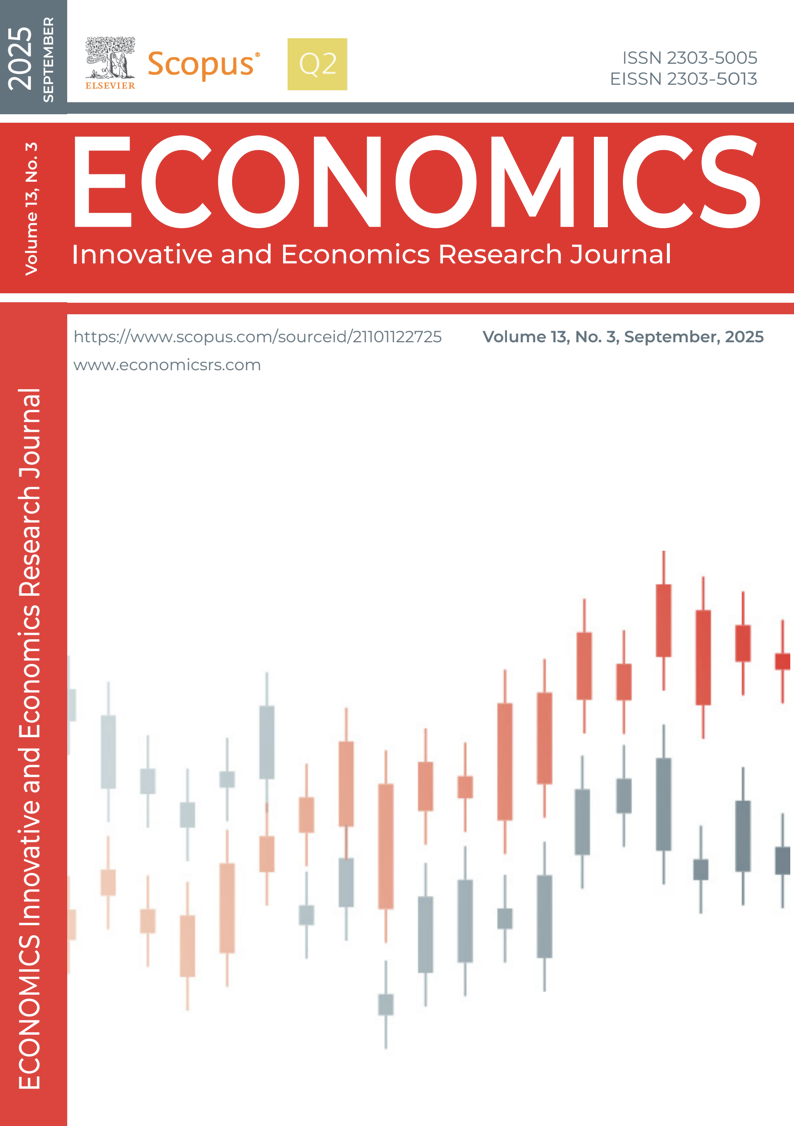GREEN GROWTH IN SCANDINAVIA: ASSESSING THE ROLE OF ENVIRONMENTAL TAXATION, GREEN INNOVATION, TRADE, AND URBANIZATION IN ADVANCING CLEAN ENERGY CONSUMPTION
DOI:
https://doi.org/10.2478/eoik-2025-0054Keywords:
Carbon taxes, Renewable transitions, Nordic Region, Urban Planning, Technology infrastructureAbstract
The research analyses the drivers of clean energy use (CEU) in Scan-
dinavian countries by assessing the influence of environmental taxa-
tion (ETR), green innovation (GRI), trade openness (TRD), economic
growth (ECG), and urbanization (URB). In exploring these relation-
ships, the research is mainly theorized within the Energy Transition
Theory and Environmental Kuznets Curve (EKC) hypothesis frame-
work while employing panel data from 1990 to 2023 and advanced
econometric tools. Results show that while GRI and ECG significant-
ly contribute to adopting clean energies, the URB process enhances
CEU through improved infrastructure and technology adoption. It
reveals that environmental taxation has an adverse short-term impact
by raising energy costs, while trade openness yields ambiguous re-
sults. The study confirms the theoretical frameworks and highlights
the interplay among socio-technical and economic dimensions as crit-
ical enablers and barriers for energy transitions. Thus, environmental
taxation should be complemented with subsidies, more significant in-
vestments in green innovation should be made, and economic growth
should be used to ensure clean energy infrastructure and clean energy
in urban planning. These findings provide actionable strategies to fast-
track clean energy transitions in Scandinavia and beyond, thus ensur-
ing economic growth and harmony with environmental sustainability.
References
Ahmad, M., Muslija, A., & Satrovic, E. (2021). Does economic prosperity lead to environmental sustain-
ability in developing economies? Environmental Kuznets curve theory. Environmental Science
and Pollution Research, 28(18), 22588–22601. https://doi.org/10.1007/s11356-020-12276-9
Aldegheishem, A. (2024). The relationship between urbanization, energy consumption, economic growth,
and carbon dioxide emissions in middle eastern countries: Saudi Arabia, Jordan and Egypt. En-
vironmental Research Communications, 6(6), 65011. https://doi.org/10.1088/2515-7620/ad5791
Alper, F. O., Golcek, A. G., & Alper, A. E. (2024). The relationship between environmental taxes and re-
newable energy in Europe: A pathway to sustainable development? Reference Module in Social
Sciences. https://doi.org/10.1016/b978-0-44-313776-1.00211-7
Andrews-Speed, P. (2016). Applying institutional theory to the low-carbon energy. Energy Research &
Social Science, 13, 216–225. https://doi.org/10.1016/j.erss.2015.12.011
Aneja, R., Yadav, M., & Gupta, S. (2024). The dynamic impact assessment of clean energy and green
innovation in realizing environmental sustainability of G‐20. Sustainable Development, 32(3),
–2473. https://doi.org/10.1002/sd.2797
Arkolakis, C., & Walsh, C. (2023). Clean growth. National Bureau of Economic Research. No: 31615.
https://doi.org/10.3386/w31615
Aydin, F. F. (2023). Effect of economic growth, energy use, trade openness and foreign direct invest-
ments on carbon dioxide emissions. Evidence from G8 countries. Environmental Science and
Pollution Research. https://doi.org/10.1007/s11356-023-29827-5
Bai, D., Li, M., Wang, Y., Mallek, S., & Shahzad, U. (2024). Impact mechanisms and spatial and tem-
poral evolution of digital economy and green innovation: A perspective based on regional col-
laboration within urban agglomerations. Technological Forecasting and Social Change, 207,
https://doi.org/10.1016/j.techfore.2024.123613
Baltagi, B. H., Feng, Q., & Kao, C. (2012). A Lagrange Multiplier test for cross-sectional dependence
in a fixed effects panel data model. Journal of Econometrics, 170(1), 164–177. https://doi.
org/10.1016/j.jeconom.2012.04.004
Barkat, K., Alsamara, M., Kwifi, O. A. Al, & Jarallah, S. (2024). Does trade openness mitigate environmen-
tal degradation in Organisation for Economic Co‐operation and Development (OECD) countries?
Implications for achieving sustainable development. https://doi.org/10.1111/1477-8947.12412
Bashir, M. F., Shahbaz, M., Ma, B., & Alam, K. (2024). Evaluating the roles of energy innovation,
fossil fuel costs and environmental compliance towards energy transition in advanced industri-
al economies. Journal of Environmental Management, 351, 119709. https://doi.org/10.1016/j.
jenvman.2023.119709
Bekun, F. V., Fumey, M. P., Staniewski, M. W., Sun, L., & Agboola, P. O. (2025). Energy intensive growth
and the transition pathways: Insights into the role of renewable energy and open market con-
ditions in developing countries. Energy, 135192. https://doi.org/10.1016/j.energy.2025.135192
Borgi, H., Alessa, N., Hamza, F., & Albitar, K. (2024). The impact of green innovation and renewable energy
on CO2 emissions in G7 nations. Heliyon, 10(10). https://doi.org/10.1016/j.heliyon.2024.e31142
Breusch, T. S., & Pagan, A. R. (1980). The Lagrange Multiplier Test and its Applications to Mod-
el Specification in Econometrics. The Review of Economic Studies, 47(1), 239. https://doi.
org/10.2307/2297111
Bruce, N., & Ellis, G. (2023). Green taxes and policies for environmental protection. In Taxing Choices
for Managing Natural Resources, the Environment, and Global Climate Change: Fiscal Sys-
tems Reform Perspectives, 83–119. Springer.
Caragliu, A., & Graziano, M. (2022). The spatial dimension of energy transition policies, practices and
technologies. Energy Policy, 168, 113154. https://doi.org/10.1016/j.enpol.2022.113154
Chen, D. (2022). Trade barrier decrease and environmental pollution improvement: new evidence from Chi-
na’s firm-level pollution data. China Political Economy. https://doi.org/10.1108/cpe-07-2022-0008
Sackitey G. M. et al. / Economics - Innovative and Economics Research Journal, doi: 10.2478/eoik-2025-0054
Chen, J., Zheng, Z., Han, X., Zhao, M., & Yin, M. (2023). Promoting or inhibiting? Green fiscal policy
and urban green innovation. Chinese Journal of Population, Resources and Environment, 21(4),
–268. https://doi.org/10.1016/j.cjpre.2023.11.008
Cui, G. (2024). How do environmental taxes affect the environmental investment of high-emission en-
terprises: Evidence from China. Journal of Environmental Management, 370, 122629. https://
doi.org/10.1016/j.jenvman.2024.122629
Dai, B., Amarteifio, E. N. A., Kyere, F., & Sampene, A. K. (2024). Examining the dynamics between
economic development, tourism, renewable energy and life expectancy in the Nordic econo-
mies. Environmental Research. https://doi.org/10.1016/j.envres.2024.118900
Dašić, D., Ilievska Kostadinović, M., Vlajković, M., & Pavlović, M. (2024). Digital Literacy in the Ser-
vice of Science and Scientific Knowledge. International Journal of Cognitive Research in Sci-
ence, Engineering and Education (IJCRSEE), 12(1), 219–227. https://doi.org/10.23947/2334-
-2024-12-1-219-227
Depren, S. K., Kartal, M. T., Çelikdemir, N. Ç., & Depren, Ö. (2022). Energy consumption and en-
vironmental degradation nexus: A systematic review and meta-analysis of fossil fuel and re-
newable energy consumption. Ecological Informatics, 70, 101747. https://doi.org/10.1016/j.
ecoinf.2022.101747
Dev, T., Haghiri, M., & Sabau, G. (2024). Impacts of Urbanization on Energy Consumption in the
South Asian Association for Regional Cooperation Zone. Sustainability, 16(18), 8141. https://
doi.org/10.3390/su16188141
Dobrovolska, O., Günther, S., Chernetska, O., Dubrova, N., & Kachula, S. (2024). Environmentally
related taxes and their influence on decarbonization of the economy. Environmental Economics,
(1), 174. http://dx.doi.org/10.21511/ee.15(1).2024.13
Driscoll, J. C., & Kraay, A. C. (1998). Consistent covariance matrix estimation with spatial-
ly dependent panel data. Review of Economics and Statistics, 80(4), 549–560. https://doi.
org/10.1162/003465398557825
Dumitrescu, E.-I., & Hurlin, C. (2012). Testing for Granger non-causality in heterogeneous panels. Eco-
nomic Modelling, 29(4), 1450–1460. https://doi.org/10.1016/j.econmod.2012.02.014
Durán, I. A., & Saqib, N. (2024). Load Capacity Factor and Environmental Quality: Unveiling the Role of
Economic Growth, Green Innovations, and Environmental Policies in G20 Economies. Internation-
al Journal of Energy Economics and Policy, 14(6), 287–294. https://doi.org/10.32479/ijeep.17413
Elhassan, T. (2025). Green Technology Innovation, Green Financing, and Economic Growth in G7
Countries: Implications for Environmental Sustainability. ECONOMICS - Innovative and Eco-
nomics Research Journal, 13(1), 69–91. https://doi.org/10.2478/eoik-2025-0023
Esmaeilpour Moghadam, H., & Karami, A. (2024). Green innovation: exploring the impact of environ-
mental patents on the adoption and advancement of renewable energy. Management of Environ-
mental Quality: An International Journal, 35(8), 1815–1835. https://doi.org/10.1108/MEQ-10-
-0360
Fajdetić, B., & Festić, M. (2024). Renewable Energy Sources in Sustainable Growth. In Corporate Gover-
nance and CSR Strategies for Sustainability, 284–309. IGI Global. https://doi.org/10.4018/979-
-3693-5863-4.ch012
Fatur Šikić, T., & Hodžić, S. (2023). Can environmental taxes decrease final energy consumption in the
old and new EU countries? Economic Research-Ekonomska Istraživanja, 36(3). https://doi.org/
1080/1331677X.2023.2271968
Fumey, M. P., Sackitey, G. M., & Wiredu, J. (2024). Neutralizing the surging environmental pollution
amidst renewable energy consumption and economic growth in Ghana: Insights from ARDL
and quantile regression analysis. Sustainable Social Development. 2024; 2 (6): 2891. In Devel-
opment, 2(6), 2891. https://doi.org/10.54517/ssd2891
Geels, F. W., & Schot, J. (2007). Typology of sociotechnical transition pathways. Research Policy,
(3), 399–417. https://doi.org/10.1016/j.respol.2007.01.003
Green Growth in Scandinavia: Assessing the Role of Environmental Taxation, Green Innovation, Trade, and
Urbanization in Advancing Clean Energy Consumption
Ghorbani, Y., Zhang, S. E., Bourdeau, J. E., Chipangamate, N. S., Rose, D. H., Valodia, I., & Nwaila,
G. T. (2024). The strategic role of lithium in the green energy transition: Towards an OPEC-
style framework for green energy-mineral exporting countries (GEMEC). Resources Policy, 90,
https://doi.org/10.1016/j.resourpol.2024.104737
Haider, S. L., Mehdi, W., Mustafa, S. M., & Abbas, S. W. (2024). Economic Growth, Industrialization,
and CO2 Emissions in Pakistan: Insights from ARDL Modeling. IRASD Journal of Economics,
(3), 664–679. https://doi.org/10.52131/joe.2024.0603.0231
Han, J., Zeeshan, M., Ullah, I., Rehman, A., & Afridi, F. E. A. (2022). Trade openness and urbanization
impact on renewable and non-renewable energy consumption in China. Environmental Science
and Pollution Research, 29(27), 41653–41668. https://doi.org/10.1007/s11356-021-18353-x
Hassan, Q., Viktor, P., Al-Musawi, T. J., Ali, B. M., Algburi, S., Alzoubi, H. M., Al-Jiboory, A. K.,
Sameen, A. Z., Salman, H. M., & Jaszczur, M. (2024). The renewable energy role in the glob-
al energy Transformations. Renewable Energy Focus, 48, 100545. https://doi.org/10.1016/j.
ref.2024.100545
Hussein, N. A.-H. K., & Basel, O. M. (2024). Integrating Renewable Energy Systems into Urban Planning for
Sustainable Cities. ESTIDAMAA, 2024, 15–21. https://doi.org/10.70470/ESTIDAMAA/2024/003
Iorember, P. T., Usman, O., & Jelilov, G. (2019). Asymmetric effects of renewable energy consumption,
trade openness and economic growth on environmental quality in Nigeria and South Africa.
MPRA Paper, No. 96333. https://mpra.ub.uni-muenchen.de/96333/
Kao, C. (1999). Spurious regression and residual-based tests for cointegration in panel data. Journal of
Econometrics, 90(1), 1–44. https://doi.org/10.1016/s0304-4076(98)00023-2
Khan, I., Zakari, A., Ahmad, M., Irfan, M., & Hou, F. (2022). Linking energy transitions, energy con-
sumption, and environmental sustainability in OECD countries. Gondwana Research, 103,
–457. https://doi.org/10.1016/j.gr.2021.10.026
Khan, Z., Ali, A., Rizwan, M., & Ismail, M. (2024). Economic Growth, Access to Clean Fuels & Technol-
ogies for Cooking, and Renewable Energy Consumption: Case of South Asian Economies. IRASD
Journal of Energy & Environment, 5(1), 12–23. https://doi.org/10.52131/jee.2024.0501.0042
Khiali-Miab, A., Patt, A., & Krütli, P. (2024). Empowering a sustainable urban future: The key role
of coordinated settlement development for optimising energy efficiency and socio-economic
welfare. Sustainable Cities and Society, 107, 105418. https://doi.org/10.1016/j.scs.2024.105418
Lawal, A. I., Ozturk, I., Olanipekun, I. O., & Asaleye, A. J. (2020). Examining the linkages between
electricity consumption and economic growth in African economies. Energy, 208, 118363.
https://doi.org/10.1016/j.energy.2020.118363
Le, T.-H. (2022). Trade openness, energy usage and environmental quality. In Frontiers in Energy Re-
search, 10, 1001205. Frontiers Media SA. https://doi.org/10.3389/fenrg.2022.1001205
Li, Y., Wu, Y., Chen, Y., & Huang, Q. (2021). The influence of foreign direct investment and trade
opening on green total factor productivity in the equipment manufacturing industry. Applied
Economics, 53(57), 6641–6654. https://doi.org/10.1080/00036846.2021.1947961
Mabrouki, M. (2019). The Swedish economy is doing well thanks to innovation: an analysis from ARDL
approach. MPRA Paper, No. 102367. https://mpra.ub.uni-muenchen.de/102367/
Madaleno, M., & Nogueira, M. C. (2023). How Renewable Energy and CO2 Emissions Contribute
to Economic Growth, and Sustainability—An Extensive Analysis. Sustainability. https://doi.
org/10.3390/su15054089
Marra, A., Colantonio, E., Cucculelli, M., & Nissi, E. (2024). The ‘complex’ transition: Energy intensity
and CO2 emissions amidst technological and structural shifts. Evidence from OECD countries.
Energy Economics. https://doi.org/10.1016/j.eneco.2024.107702
Masoud, N. (2024). Driving green innovation: assessing the impact of environmental tax policies and
green finance on heavily polluting industries. Social Transformations in Chinese Societies.
http://dx.doi.org/10.1108/STICS-08-2024-0013
Sackitey G. M. et al. / Economics - Innovative and Economics Research Journal, doi: 10.2478/eoik-2025-0054
Mastilo, Z., Barić, F. & Puška, A. (2025). Challenges and Opportunities of Implementing Digital Pay-
ment Systems in Southeast European Countries. Journal of Central Banking Theory and Prac-
tice, 14(2), 5-28. https://doi.org/10.2478/jcbtp-2025-0011
Milutinović, O., Anđelić, S., Garabinović, D., & Bajac, M. (2024). Management and Organization of
Human Resources in Science and Technology of the Republic of Serbia. International Jour-
nal of Cognitive Research in Science, Engineering and Education (IJCRSEE), 12(1), 89–101.
https://doi.org/10.23947/2334-8496-2024-12-1-89-101
Moro, K. D., Xi, J., Fumey, M. P., Awuye, S. K., & Sackitey, G. M. (2025). Industrialization, energy
demand and environmental pollution nexus in MINT economies. Does cleaner energy transition
and environmental technology play a mitigating role? Journal of Environmental Management,
, 124451. https://doi.org/10.1016/j.jenvman.2025.124451
Nematchoua, M. K., Sadeghi, M., & Reiter, S. (2021). Strategies and scenarios to reduce energy con-
sumption and CO2 emission in the urban, rural and sustainable neighbourhoods. Sustainable
Cities and Society, 72, 103053. https://doi.org/10.1016/j.scs.2021.103053
Nketiah, E., Adeleye, B. N., & Okoye, L. U. (2024). Comparative Investigation of Growth-Led Energy
and Environmental Kuznets Curve Hypotheses in Ghana and Nigeria. Journal of the Knowledge
Economy, 1–22. https://doi.org/10.1007/s13132-024-02224-0
Nong, D., Simshauser, P., & Nguyen, D. B. (2021). Greenhouse gas emissions vs CO2 emissions: Com-
parative analysis of a global carbon tax. Applied Energy, 298, 117223. https://doi.org/10.1016/j.
apenergy.2021.117223
Obobisa, E. S. (2024). An econometric study of eco‐innovation, clean energy, and trade openness toward
carbon neutrality and sustainable development in OECD countries. Sustainable Development,
(4), 3075–3099. https://doi.org/10.1002/sd.2829
OECD. (2024). Data. In OECD. https://www.oecd.org/en/data.html
Pantelaiou, I., Hatzipanayotou, P., Konstantinou, P., Xepapadeas, A., & Xepapadeas, A. (2020). 2. Can Clean-
er Environment Promote International Trade? Environmental Policies as Export Promoting Mecha-
nisms. Environmental and Resource Economics. https://doi.org/10.1007/S10640-020-00408-1
Pesaran, M. H., Schuermann, T., & Weiner, S. M. (2004). Modeling Regional Interdependencies Using a
Global Error-Correcting Macroeconometric Model. Journal of Business & Economic Statistics,
(2), 129–162. https://doi.org/10.1198/073500104000000019
Pesaran, M. H., Ullah, A., & Yamagata, T. (2008). A bias-adjusted LM test of error cross-section independence.
The Econometrics Journal, 11(1), 105–127. https://doi.org/10.1111/j.1368-423x.2007.00227.x
Pesaran, M. H., & Yamagata, T. (2008). Testing slope homogeneity in large panels. Journal of Econo-
metrics, 142(1), 50–93. https://doi.org/10.1016/j.jeconom.2007.05.010
Prasetyo, P. E., & Kistanti, N. R. (2023). The potential of informal institutions in promoting green enter-
preneurship (ge) and sustainable socio-economic development. ECONOMICS-Innovative and
Economics Research Journal, 11(Special issue 1), 1-20. https://doi.org/10.2478/eoik-2023-0061
Ramachandran, S., Rupakheti, M., Cherian, R., & Lawrence, M. (2022). Climate Benefits of Cleaner
Energy Transitions in East and South Asia Through Black Carbon Reduction. Frontiers in Envi-
ronmental Science. https://doi.org/10.3389/fenvs.2022.842319
Saleem, H., Khan, M. B., & Mahdavian, S. M. (2022). The role of green growth, green financing,
and eco-friendly technology in achieving environmental quality: evidence from selected Asian
economies. Environmental Science and Pollution Research, 29(38), 57720–57739. https://doi.
org/10.1007/s11356-022-19799-3
Sampene, A. K., Li, C., & Wiredu, J. (2024). Environmental technology to stimulate life expectancy:
A deep dive into the role of PM2. 5 and carbon emission. Environment International, 109118.
https://doi.org/10.1016/j.envint.2024.109118
Senthil, R. (2022). Recent innovations in solar energy education and research towards sustainable en-
ergy development. Acta Innovations, 42, 27–49. https://doi.org/10.32933/ActaInnovations.42.3
Green Growth in Scandinavia: Assessing the Role of Environmental Taxation, Green Innovation, Trade, and
Urbanization in Advancing Clean Energy Consumption
Shen, H., Wang, Y., & Deng, R. (2021). 3. Can Clean Energy Consumption Promotethe Decoupling Be-
tween Economic Growthand Environmental Pollution? – Spatial EmpiricalAnalysis Based on
China. Polish Journal of Environmental Studies. https://doi.org/10.15244/PJOES/131837
Siddique, H. M. A., & Alvi, S. (2025). Impacts of industrialization, trade openness, renewable energy
consumption, and urbanization on the environment in South Asia. Environment, Development
and Sustainability, 1–24. https://doi.org/10.1007/s10668-024-05846-1
Sommer, S., Mattauch, L., & Pahle, M. (2022). Supporting carbon taxes: The role of fairness. Ecological
Economics, 195, 107359. https://doi.org/10.1016/j.ecolecon.2022.107359
Sovacool, B. K. (2017). Contestation, contingency, and justice in the Nordic low-carbon energy transi-
tion. Energy Policy, 102, 569–582. https://doi.org/10.1016/j.enpol.2016.12.045
Sovacool, B. K., Noel, L., Kester, J., & de Rubens, G. Z. (2018). Reviewing Nordic transport challeng-
es and climate policy priorities: Expert perceptions of decarbonisation in Denmark, Finland,
Iceland, Norway, Sweden. Energy, 165, 532–542. https://doi.org/10.1016/j.energy.2018.09.110
Srinivasan, R. S., Manohar, B., & Issa, R. R. A. (2020). Urban building energy CPS (UBE-CPS): re-
al-time demand response using digital twin. Cyber-Physical Systems in the Built Environment,
–322. https://doi.org/10.1007/978-3-030-41560-0_17
Streimikiene, D. (2024a). Comparative Assessment of Climate-responsible Tourism Destinations in Viseg-
rad Countries. Montenegrin Journal of Economics, 20(3), 247–257. https://mnje.com/sites/mnje.
com/files/v20n3/247-257%20-%20Streimikiene.pdf
Su, S., Qamruzzaman, M., & Karim, S. (2023). Charting a sustainable future: the impact of economic
policy, environmental taxation, innovation, and natural resources on clean energy consumption.
Sustainability, 15(18), 13585. https://doi.org/10.3390/su151813585
Sun, Y., Belgacem, S. Ben, Khatoon, G., & Nazir, F. (2023). Impact of environmental taxation, green in-
novation, economic growth, and renewable energy on green total factor productivity. Gondwana
Research. https://doi.org/10.1016/j.gr.2023.10.016
Tan, K. M., Babu, T. S., Ramachandaramurthy, V. K., Kasinathan, P., Solanki, S. G., & Raveendran, S.
K. (2021). Empowering smart grid: A comprehensive review of energy storage technology and
application with renewable energy integration. Journal of Energy Storage, 39, 102591. https://
doi.org/10.1016/j.est.2021.102591
Tolliver, C., Fujii, H., Keeley, A. R., & Managi, S. (2021). Green innovation and finance in Asia. Asian
Economic Policy Review, 16(1), 67–87. https://doi.org/10.1111/aepr.12320
Toni, N. (2025). Supply Chain Sustainability and Financial Performance: The Role of E-Commerce,
Digital Banking and Digital Marketing of SMEs. Economics - innovative and economics re-
search journal, 13(1), 487–507. https://doi.org/10.2478/eoik-2025-0027
Trimech, A. (2024). Exploring the interplay of renewable energy and carbon dioxide emissions across
US sectors through wavelet approach. Environmental Progress & Sustainable En-
ergy. https://doi.org/10.1002/ep.14454
Wang, Q., Ren, F., & Li, R. (2024). Exploring the impact of geopolitics on the environmental Kuznets
curve research. Sustainable Development, 32(3), 1700–1722. https://doi.org/10.1002/sd.2743
WDI. (2024). World Development Indicators | DataBank. In Worldbank.org. The World Bank. https://
databank.worldbank.org/source/world-development-indicators#
Westerlund, J. (2007). Panel cointegration tests of the Fisher effect. Journal of Applied Econometrics,
(2), 193–233. https://doi.org/10.1002/jae.967
Wiredu, J., Yang, Q., Inuwa, U. L., & Sampene, A. K. (2023). Energy transition in Africa: The role of
human capital, financial development, economic development, and carbon emissions. Environ-
mental Science & Policy, 146, 24–36. https://doi.org/10.1016/j.envsci.2023.04.021
Wiredu, J., Yang, Q., Lu, T., Sampene, A. K., & Wiredu, L. O. (2025). Delving into environmental
pollution mitigation: does green finance, economic development, renewable energy resource,
life expectancy, and urbanization matter? Environment, Development and Sustainability, 1–30.
https://doi.org/10.1007/s10668-024-05934-2
Sackitey G. M. et al. / Economics - Innovative and Economics Research Journal, doi: 10.2478/eoik-2025-0054
Wu, H., Yang, H., Hu, X., Zheng, L., Li, J., Li, Y., Wang, X., Ge, W., Zhou, Y., Liu, Y., Liu, J., Wang,
Y., Ma, J., & Tao, S. (2024). Complementing carbon tax with renewable energy investment to
decarbonize the energy system in China. Renewable and Sustainable Energy Reviews, 189,
https://doi.org/10.1016/j.rser.2023.113997
Yan, H., Qamruzzaman, M., & Kor, S. (2023). Nexus between Green Investment, Fiscal Policy, Envi-
ronmental Tax, Energy Price, Natural Resources, and Clean Energy—A Step towards Sustain-
able Development by Fostering Clean Energy Inclusion. Sustainability (Switzerland), 15(18),
–25. https://doi.org/10.3390/su151813591
Zaghdoud, O. (2025). Environmental Fiscal Policies and the Double Dividend Hypothesis: A Dynamic
CGE-OLG Analysis in Tunisia. Economics - innovative and economics research journal, 13(2),
–53. https://doi.org/10.2478/eoik-2025-0029
Zhang, J., Taqi, S. A., Akbar, A., Darwish, J. A., Abbas, S., Alam, S., Gao, Y., Shahbaz, M. Q., & Butt, N. S.
(2024). Green Innovation in Business: A Comprehensive Bibliometric Analysis of Trends, Contrib-
utors, and Future Directions. Sustainability, 16(24), 10956. https://doi.org/10.3390/su162410956
Zhao, X., Mahendru, M., Ma, X., Rao, A., & Shang, Y. (2022). Impacts of environmental regulations
on green economic growth in China: New guidelines regarding renewable energy and energy
efficiency. Renewable Energy, 187, 728–742. https://doi.org/10.1016/j.renene.2022.01.076
Zhu, Y., Taylor, D., & Wang, Z. (2023). The role of environmental taxes on carbon emissions in coun-
tries aiming for net-zero carbon emissions: Does renewable energy use matter? Renewable En-
ergy, 119239. https://doi.org/10.1016/j.renene.2023.119239
Zolkover, A., Lagovska, O., Valihura, V., Zhelef, G., & Shynkar, T. (2024). Assessing the Impact of
Green Taxation Policies on Sustainable Growth. Grassroots Journal of Natural Resources, 7(3),
Downloads
Published
How to Cite
Issue
Section
License
Copyright (c) 2025 ECONOMICS - INNOVATIVE AND ECONOMICS RESEARCH JOURNAL

This work is licensed under a Creative Commons Attribution-NonCommercial-NoDerivatives 4.0 International License.























